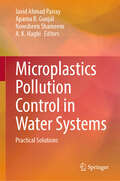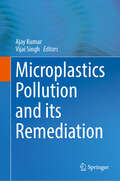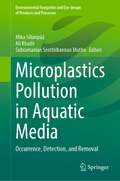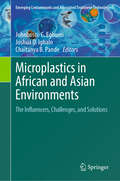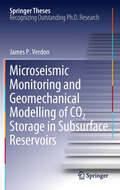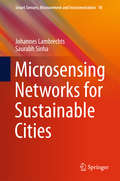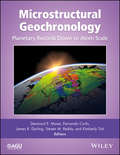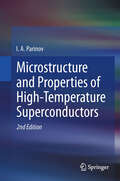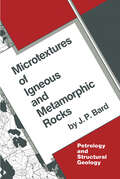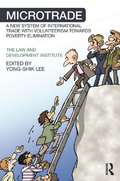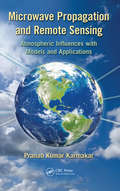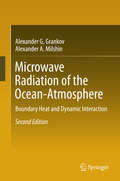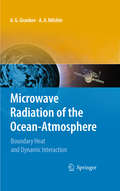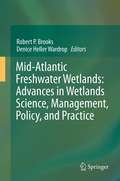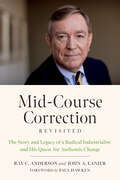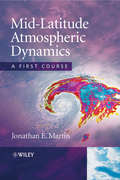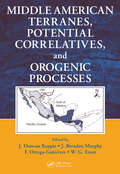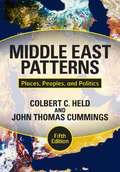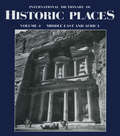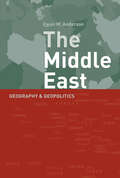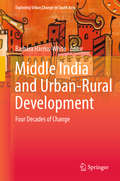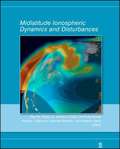- Table View
- List View
Microplastics Pollution Control in Water Systems: Practical Solutions
by Javid Ahmad Parray A. K. Haghi Nowsheen Shameem Aparna B. GunjalThis book covers advanced solutions for managing water systems pollution caused by microplastics. It provides a comprehensive overview of microplastic contamination, spanning detection in municipal water systems, removal from wastewater using sustainable technologies, and monitoring methods in natural environments. The book also discusses the impacts of microplastics on water bodies and the limitations of current treatment processes, presenting complementary methods to address microplastic contamination. In this book, particular attention is given to practical insights into dealing with microplastic pollution, and readers will find several case studies such as the application of nonwoven electrospun nano-membranes and activated carbon adsorbents for microplastics removal, alongside novel laboratory experiments and field methods like the invertebrate kick-netting technique. The book also offers a forward-looking approach, discussing cutting-edge topics like the application of artificial intelligence for microplastic identification, and the impact of land use patterns on soil microplastic pollution. The book concludes with a chapter devoted to smart management solutions, providing a glimpse into future trends and perspectives in the field. Given its breadth and coverage, the book appeals not only to academics and researchers in the fields of environmental chemistry and environmental sciences but also to professionals and policymakers dealing with microplastic pollution and research.
Microplastics Pollution and its Remediation
by Ajay Kumar Vijai SinghThe book elaborates on microplastics as a global concern, prompting the need for comprehensive understanding and effective management. It thoroughly explores the various aspects of microplastics, addressing their detection, separation, and contamination in diverse ecosystems. The introductory chapter highlights the global risks associated with microplastics while presenting the challenges and opportunities in tackling this issue. It focuses on the detection techniques employed to identify microplastics, providing insights into the analytical methods and technologies utilized in their characterization. It delves into the separation techniques used to extract microplastics from complex environmental matrices, aiding in their accurate quantification and analysis. The subsequent chapters examine the presence and impact of microplastics in specific ecosystems, including aquatic and terrestrial. It investigates the prevalence of microplastics in water bodies and their detrimental effects on aquatic organisms and elucidates their distribution, transport, and ecological implications on land-dwelling organisms. The book further explores microplastics' occurrence in foods, cosmetics, and air pollution and associated health hazards. It delves into the lesser-known aspects of microplastics influence on nitrogen cycling and nitrous oxide emissions, offering valuable insights into their impact on biogeochemical processes. It discusses microplastics environmental risks and hazards, covering the ecological, biodiversity, and ecosystem-level impacts caused by these persistent pollutants. The concluding chapters focus on sustainable management strategies for mitigating and controlling microplastics proliferation and associated risks. This book provides a comprehensive and multidisciplinary approach for understanding and addressing the challenges posed by microplastics. It serves as a valuable resource for researchers, policymakers, environmentalists, and anyone concerned about the impact of microplastics on planet. This book aims to foster sustainable management practices and contribute to a cleaner and healthier environment by unraveling microplastics complexities.
Microplastics Pollution in Aquatic Media: Occurrence, Detection, and Removal (Environmental Footprints and Eco-design of Products and Processes)
by Mika Sillanpää Subramanian Senthilkannan Muthu Ali KhadirThis book highlights one of the most important water pollutants known as Microplastics. It has been reported that humans and the environment are dealing with microplastics particles in water and aquatic media. Despite the fact that such pollution might have mainly started out from the sea, it is now in lakes, rivers, ponds and even drinking water. This book presents as overview of microplastics in freshwater environments in different regions around the world. It discusses the ecotoxicological effects of microplastics, the removal/remediation techniques of microplastics and the role of water/wastewater treatment plants in spreading microplastics. This book is a valuable resource, covering wide aspects of microplastics from sources, detection and characterization to removal and their fate in treatment plants.
Microplastics in African and Asian Environments: The Influencers, Challenges, and Solutions (Emerging Contaminants and Associated Treatment Technologies)
by Chaitanya B. Pande Johnbosco C. Egbueri Joshua O. IghaloThis innovative book tackles the pressing global environmental issue of microplastic pollution, with a particular focus on the diverse and ecologically significant regions of Africa and Asia. Through comprehensive analysis, it unveils the alarming extent of microplastic contamination in these regions, highlighting the urgent need for attention and action. The book provides a thorough introduction to microplastics, exploring their composition, formation process, and mechanisms of infiltration into terrestrial and aquatic ecosystems. It explains their transport mechanisms, their presence in air, water, soil, sediments, wetlands, and their far-reaching ecological impacts on food security and human health. It investigates their direct and indirect effects on public health, including inhalation, ingestion, toxicological implications, and overall consequences. The book also examines the interactions between human activities, socioeconomic factors, and microplastic proliferation across different environmental compartments. Drawing insights from case studies across coastal cities and remote rural areas, the book illustrates the scope and magnitude of this problem in Africa and Asia. Furthermore, it provides an overview of analytical techniques and methodologies employed in microplastic research, such as GIS, remote sensing, spectroscopy, and computational modelling. It meticulously analyzes current mitigation techniques, best practices, policy frameworks, and the role of public awareness in addressing this issue. The book offers insights into future research directions, mitigation strategies, and broader ecological and human health aspects of microplastic pollution. Designed as a graduate-level resource, this interdisciplinary book is invaluable for researchers across disciplines, policymakers working in these regions, and anyone concerned about the pervasive issue of microplastic pollution and its far-reaching consequences across several other regions of the world.
Microscopic Foundations of Relativistic Fluid Dynamics (Lecture Notes in Physics #990)
by Gabriel S. Denicol Dirk H. RischkeThis book provides an introduction to relativistic dissipative fluid dynamics, with particular emphasis on its derivation from microscopic transport theory. After a phenomenological derivation of relativistic dissipative fluid dynamics from the second law of thermodynamics, the intrinsic instabilities of relativistic Navier-Stokes theory are discussed. In turn, analytical solutions of relativistic dissipative fluid dynamics are presented. Following, the authors discuss several theories and approaches to derive transport coefficients in dissipative fluid dynamics such as the Chapman-Enskog theory, the theory of Israel and Stewart, and a more recent derivation of relativistic dissipative fluid dynamics based on kinetic theory, which constitutes the main focus of the second part of this book. This book is intended for advanced graduate students and researchers in physics and requires basic knowledge of the theory of special and general relativity. It should be of particular interest to researchers that apply relativistic fluid dynamics in cosmology, astrophysics, and high-energy nuclear physics.
Microseismic Monitoring and Geomechanical Modelling of CO2 Storage in Subsurface Reservoirs
by James P. VerdonThis thesis presents an impressive summary of the potential to use passive seismic methods to monitor the sequestration of anthropogenic CO2 in geologic reservoirs. It brings together innovative research in two distinct areas - seismology and geomechanics - and involves both data analysis and numerical modelling. The data come from the Weyburn-Midale project, which is currently the largest Carbon Capture and Storage (CCS) project in the world. James Verdon's results show how passive seismic monitoring can be used as an early warning system for fault reactivation and top seal failure, which may lead to the escape of CO2 at the surface.
Microsensing Networks for Sustainable Cities
by Saurabh Sinha Johannes LambrechtsThis book explores the microsensing technologies and systems now available to monitor the quality of air and water within the urban environment and examines their role in the creation of sustainable cities against the background of the challenges posed by rapid urbanization. The opening section addresses the theoretical and conceptual background of microsensing networks. The coverage includes detailed description of microsensors, supported by design-specific equations, and clear explanation of the ways in which devices that harvest energy from ambient sources can detect and quantify pollution. The practical application of such systems in addressing environmental impacts within cities and in sustainable urban planning is then discussed with the aid of case studies in developing countries. The book will be of interest to all who wish to understand the benefits of microsensing networks in promoting sustainable cities through better delivery of information on health hazards and improved provision of data to environmental agencies and regulatory bodies in order to assist in monitoring, decision-making, and regulatory enforcement.
Microstructural Geochronology: Planetary Records Down to Atom Scale
by Desmond E. Moser Fernando Corfu James R. Darling Steven M. Reddy Kimberly TaitMicrostructural Geochronology Geochronology techniques enable the study of geological evolution and environmental change over time. This volume integrates two aspects of geochronology: one based on classical methods of orientation and spatial patterns, and the other on ratios of radioactive isotopes and their decay products. The chapters illustrate how material science techniques are taking this field to the atomic scale, enabling us to image the chemical and structural record of mineral lattice growth and deformation, and sometimes the patterns of radioactive parent and daughter atoms themselves, to generate a microstructural geochronology from some of the most resilient materials in the solar system. First compilation of research focusing on the crystal structure, material properties, and chemical zoning of the geochronology mineral archive down to nanoscale Novel comparisons of mineral time archives from different rocky planets and asteroids and their shock metamorphic histories Fundamentals on how to reconstruct and date radiogenic isotope distributions using atom probe tomography Microstructural Geochronology will be a valuable resource for graduate students, academics, and researchers in the fields of petrology, geochronology, mineralogy, geochemistry, planetary geology, astrobiology, chemistry, and material science. It will also appeal to philosophers and historians of science from other disciplines.
Microstructure and Properties of High-Temperature Superconductors
by I. A. ParinovThe main features of high-temperature superconductors (HTSC) that define their properties are intrinsic brittleness of oxide cuprates, the layered anisotropic structure and the supershort coherence length. Taking into account these features, this treatise presents research into HTSC microstructure and properties, and also explores the possibilities of optimization of the preparation techniques and superconducting compositions. The "composition-technique-experiment-theory-model," employed here, assumes considerable HTSC defectiveness and structure heterogeneity and helps to draw a comprehensive picture of modern representations of the microstructure, strength and the related structure-sensitive properties of the materials considered. Special attention is devoted to the Bi-Sr-Ca-Cu-O and Y-Ba-Cu-O families, which currently offer the most promising applications. Including a great number of illustrations and references, this monograph addresses students, post-graduate students and specialists, taking part in the development, preparation and research of new materials. The new edition had been updated intensively, especially experimental investigations and modeling conductive and elastic properties of HTC superconductors have been added.
Microtextures of Igneous and Metamorphic Rocks (Petrology and Structural Geology #1)
by J.P. BardAt a time when 'textural' evidence is regarded as being 'obvious' ( . . . ) it becomes more and more difficult to find illustrations or even descriptions of the arrangements of the various constituents of 'traumatized' rocks. It is helpful in consequence to advise geology students that the study of thin sections is not only concerned with the identification of their mineral content. To do so would mean they could not see the wood for the trees. Accurate identification of the indi vidual minerals that form rocks is fundamental in their description but the analysis of their textures and habits is also essential. Study of textural features enforces constraints upon the inter pretation of the origin and history of a rock. The analysis of micro textures cannot and should never be an aim in itself, out must be sup ported by qualitative and quantitative correlations with theories of petrogenesis. The aim here is to help the reader to bridge the gap between his observations of rocks unqer the microscope and petrogenetic theories. The habits or architectures of crystals in rocks may resemble those studied by metallurgists and glass scientists. Analysis of micro textures is undergoing change engendered by comparisonS between manu factured and hence minerals. This can be seen from the increased number of publications dealing with crystal ~rowth or deformation processes at microscopic scales to which the name of 'nanotectonics' has been applied.
Microtrade: A New System of International Trade with Volunteerism Towards Poverty Elimination (Routledge Research in International Economic Law)
by Yong-Shik LeeWith contributions from well-regarded scholars of international economic law, this book sets out the case for an innovative solution to extreme poverty which utilizes international trade and its legal framework to relieve populations of the poorest countries around the world of extreme poverty. "Microtrade" is international trade on a small scale, based primarily on manually produced products using small amounts of capital and low levels of technology available at a local level in lesser developed countries. This book explores the theory, application, and legal framework for microtrade. In the first part of the book the architect of the microtrade theory, Yong-Shik Lee, offers a theoretical framework for microtrade including its basic elements, product demand and operational issues, legal issues, and the global management and facilitation of microtrade. The book then goes on to look at issues including the structure and financing of microtrade, e-commerce, government procurement, and the fair trade movement’s possible relationship with microtrade. . The final part of the book considers empirical case studies of microtrade with agricultural products. The book shows how microtrade, if effectively administered on a global scale, can do much to end extreme poverty.
Microwave Propagation and Remote Sensing: Atmospheric Influences with Models and Applications
by Pranab Kumar KarmakarBecause prevailing atmospheric/troposcopic conditions greatly influence radio wave propagation above 10 GHz, the unguided propagation of microwaves in the neutral atmosphere can directly impact many vital applications in science and engineering. These include transmission of intelligence, and radar and radiometric applications used to probe the atmosphere, among others. Where most books address either one or the other, Microwave Propagation and Remote Sensing: Atmospheric Influences with Models and Applications melds coverage of these two subjects to help readers develop solutions to the problems they present. This reference offers a brief, elementary account of microwave propagation through the atmosphere and discusses radiometric applications in the microwave band used to characterize and model atmospheric constituents, which is also known as remote sensing. Summarizing the latest research results in the field, as well as radiometric models and measurement methods, this book covers topics including: Free space propagation Reflection, interference, polarization, and other key aspects of electromagnetic wave propagation Radio refraction and its effects on propagation delay Methodology of estimating water vapor attenuation using radiosonde data Knowledge of rain structures and use of climatological patterns to estimate/measure attenuation of rain, snow, fog, and other prevalent atmospheric particles and human-made substances Dual/multifrequency methodology to deal with the influence of clouds on radiometric attenuation Deployment of microwaves to ascertain various tropospheric conditions Composition and characteristics of the troposphere, to help readers fully understand microwave propagation Derived parameters of water, free space propagation, and conditions and variable constituents such as water vapor and vapor pressure, density, and ray bending
Microwave Radiation of the Ocean-Atmosphere
by Alexander G. Grankov Alexander A. MilshinThe book describes different approaches to the analysis of heat and dynamic processes in the ocean-atmospheric interface with satellite passive radiometric observations at microwaves. It examines the feasibility of determining synoptic, seasonal and year-to-year variations of sensible, latent and momentum fluxes to a useful accuracy using the DMSP SSM/I and EOS Aqua AMSR-E data directly from the measured brightness temperatures. An important object in the studies is the North Atlantic with emphasize on the areas with high midlatitude cyclon activity: here the main results have been obtained by combining data from the vessel experiments NEWFOUEX-88, ATLANTEX-90 and the data of microwave radiometers from the DMSP and EOS Aqua satellites. The role of vertical turbulent and horizontal advective heat transfer in forming interrelations between the brightness temperature of the system ocean-atmosphere and surface heat fluxes in the range of synoptic time scales is analyzed. Special sections of the book describe some results of analysis of reaction of the system ocean-atmosphere on passing of the tropical cyclone Katrina (August 2005) in the Florida Strait as well as a behavior of the system in the period of a time preceding to origination the cyclone Humberto (September 2007) in the Mexico Gulf. The long-term goal of this research is the search for effects and regularities, which can explain the reasons for the tropical cyclones appearance. Some characteristics of the tropical cyclones (brightness temperature and heat contrasts, etc. ) are compared with those for midlatitude cyclones. At the same time as covering a key topic area with implications for global warming research, this text is also usefull to students who want to gain insight into application of satellite microwave radiometric methods for studying the air-sea interaction. Key themes: microwave radiometry, air-sea interaction, midlatitude and tropical cyclones, atmosphere boundary layer, heat and momentum surface fluxes.
Microwave Radiation of the Ocean-Atmosphere
by Alexander Grankov Alexander MilshinThe book describes different approaches to the analysis of heat and dynamic processes in the ocean-atmosphere interface with satellite passive radiometric observations of microwaves. It examines the feasibility of determining synoptic, seasonal and year-to-year variations of sensible, latent heat and momentum fluxes to a useful accuracy using the DMSP SSM/I data directly from the measured brightness temperatures. In addition, the text considers the parameters of the ocean surface and the near surface atmosphere as they relate to the processes of the ocean-atmosphere heat and dynamic interaction. These processes can be analyzed from satellites using a variety of methods, including comparison of data of synchronous satellite passive microwave radiometric and direct oceanographic and meteorological measurements, and the modeling of their variations and analysis of interrelations at different time scales.
Mid-Atlantic Freshwater Wetlands: Advances in Wetlands Science, Management, Policy, and Practice
by Denice Heller Wardrop Robert P. BrooksThe lands and waters of the Mid-Atlantic Region (MAR) have changed significantly since before the 16th century when the Susquehannock lived in the area. Much has changed since Captain John Smith penetrated the estuaries and rivers during the early 17th century; since the surveying of the Mason-Dixon Line to settle border disputes among Maryland, Pennsylvania, and Delaware during the middle of the 18th century; and since J. Thomas Scharf described the physiographic setting of Baltimore County in the late 19th century. As early as 1881, Scharf provides us with an assessment of the condition of the aquatic ecosystems of the region, albeit in narrative form, and already changes are taking place - the conversion of forests to fields, the founding of towns and cities, and the depletion of natural resources. We have always conducted our work with the premise that "man" is part of, and not apart from, this ecosystem and landscape. This premise, and the historical changes in our landscape, provide the foundation for our overarching research question: how do human activities impact the functioning of aquatic ecosystems and the ecosystem services that they provide, and how can we optimize this relationship?
Mid-Course Correction Revisited: The Story and Legacy of a Radical Industrialist and his Quest for Authentic Change
by Ray Anderson John A. LanierThe original Mid-Course Correction, published over 20 years ago, became a classic in the sustainability field. It put forth a new vision for what its author, Ray C. Anderson, called the &“prototypical company of the 21st century&”—a restorative company that does no harm to society or the environment.In Mid-Course Correction, Anderson recounts his eureka moment as founder and leader of Interface, Inc., one of the world&’s largest carpet and flooring companies, and one that was doing business in all the usual ways. Bit by bit, he began learning how much environmental destruction companies like his had caused, prompting him to make a radical change. Mid-Course Correction not only outlined what eco-centered leadership looks like, it also mapped out a specific set of goals for Anderson&’s company to eliminate its environmental footprint.Those goals remain visionary even today, and this second edition delves into how Interface worked toward making them a reality, birthing one of the most innovative and successful corporate sustainability efforts in the world. The new edition also explores why we need to create not only prototypical companies, but also the prototypical economy of the twenty-first century. As our global economy shifts toward sustainability, challenges like building the circular economy and reversing global warming present tremendous opportunities for business and industry. Mid-Course Correction Revisted contains a new foreword by Paul Hawken, several new chapters by Ray C. Anderson Foundation executive director John A. Lanier, and interviews with Janine Benyus, Joel Makower, Andrew Winston, Ellen MacArthur and other leaders in green enterprise, the circular economy, and biomimicry.A wide range of business readers—from sustainability professionals to green entrepreneurs to CEOs—will find both wise advice and concrete examples in this new look at a master in corporate and environmental leadership, and the legacy he left.
Mid-Latitude Atmospheric Dynamics
by Jonathan E. MartinThis exciting text provides a mathematically rigorous yet accessible textbook that is primarily aimed at atmospheric science majors. Its accessibility is due to the texts emphasis on conceptual understanding.The first five chapters constitute a companion text to introductory courses covering the dynamics of the mid-latitude atmosphere. The final four chapters constitute a more advanced course, and provide insights into the diagnostic power of the quasi-geostrophic approximation of the equations outlined in the previous chapters, the meso-scale dynamics of thefrontal zone, the alternative PV perspective for cyclone interpretation, and the dynamics of the life-cycle of mid-latitude cyclones.Written in a clear and accessible styleFeatures real weather examples and global case studiesEach chapter sets out clear learning objectives and tests students' knowledge with concluding questions and answersA Solutions Manual is also available for this textbook on the Instructor Companion Site www.wileyeurope.com/college/martin. "...a student-friendly yet rigorous textbook that accomplishes what no other textbook has done before... I highly recommend this textbook. For instructors, this is a great book if they don't have their own class notes - one can teach straight from the book. And for students, this is a great book if they don't take good class notes - one can learn straight from the book. This is a rare attribute of advanced textbooks." Bulletin of the American Meteorological Society (BAMS), 2008
Mid-Ocean Ridges
by Roger SearleThe world's mid-ocean ridges form a single, connected global ridge system that is part of every ocean, and is the longest mountain range in the world. Geologically active, mid-ocean ridges are key sites of tectonic movement, intimately involved in seafloor spreading. This coursebook presents a multidisciplinary approach to the science of mid-ocean ridges – essential for a complete understanding of global tectonics and geodynamics. Designed for graduate and advanced undergraduate students, it will also provide a valuable reference for professionals in relevant fields. Background chapters provide a historical introduction and an overview of research techniques, with succeeding chapters covering the structure of the lithosphere and crust, and volcanic, tectonic and hydrothermal processes. A summary and synthesis chapter recaps essential points to consolidate new learning. Accessible to students and professionals working in marine geology, plate tectonics, geophysics, geodynamics, volcanism and oceanography, this is the ideal introduction to a key global phenomenon.
Middle American Terranes, Potential Correlatives, and Orogenic Processes
by J. Duncan Keppie J. Brendan Murphy F. Ortega-Gutierrez W. G. ErnstConsisting of papers that have appeared recently in International Geology Review, Middle American Terranes, Potential Correlatives, and Orogenic Processes focuses on Middle American terranes in which tectonic processes, including flat-slab subduction, for orogenic development are examined at various times since the late Mesoproterozoi
Middle East Patterns
by Colbert C. Held John Thomas CummingsAuthor Held, a former foreign-service officer in the region, joins with new co-author Cummings, a former USAID economist, in this overview for students and general readers, especially those preparing to live and work in the Middle East. The book can be used for courses in the geography of the Middle East. Part 1 describes the climate and environment of the region and traces its historical-geographical, political, and cultural evolution. This section also examines agriculture, petroleum manufacturing, industry, and geopolitics. Part 2 offers profiles of 11 countries and sub-regions, showing economic patterns, political geography, and demographics, with special attention paid to the Palestinian-Israeli conflict. This fifth edition is rewritten to take into account developments over the past five years, with new material on terrorism and the effects of development on women. This edition also adds 16 new photos to the 100+ b&w photos taken by Held during his 50 years of fieldwork and diplomatic assignments in the Middle East. Held is a former diplomat-in-residence at Baylor University, Annotation ©2011 Book News, Inc. , Portland, OR (booknews. com)
Middle East Patterns
by Colbert C. Held John Thomas CummingsNow in its fifth edition, Middle East Patterns continues to be the most comprehensive and authoritative geographical study of the region. New coauthor John Thomas Cummings joins Colbert C. Held in updating this classic work while retaining the well-received framework of past editions. The authors first cover the Middle East from a topical perspective, considering the region's biophysical, ethnographic, economic, and geopolitical patterns, and then provide in-depth country-by-country coverage. The fifth edition maintains the book's distinctive focus on geography, natural resources, and land-use patterns while integrating updated comparative material on development economics and political economy throughout the book, as well as new sections on terrorism and piracy and the effects of development on women's health issues. Richly illustrated with more than 100 photos and 60 maps, this acclaimed book remains the best accessible resource for students and general readers who seek to understand the spatial dynamics of the Middle East.
Middle East and Africa: International Dictionary of Historic Places
by Trudy Ring Noelle Watson K. A. BerneyFirst Published in 1996. Routledge is an imprint of Taylor & Francis, an informa company.
Middle East: Geography and Geopolitics
by Ewan AndersonMiddle East is a lively and much-needed update of a well-respected work. Based on W. B. Fisher's book of the same name published in 1978, Anderson provides a comprehensive account of the physical geography which has been so instrumental to the make-up of the geopolitics of the region. The book also covers the sociology, religion, society and economy of the region. With comprehensive illustrations and maps, it provides an excellent synopsis and critique of the complexities which have made this an intriguing and important regional geographical study.
Middle India and Urban-Rural Development: Four Decades of Change (Exploring Urban Change in South Asia)
by Barbara Harriss-WhiteMiddle India and Rural-Urban Development explores the socio-economic conditions of an ‘India’ that falls between the cracks of macro-economic analysis, sectoral research and micro-level ethnography. Its focus, the ‘middle India’ of small towns, is relatively unknown in scholarly terms for good reason: it requires sustained and difficult field research. But it is where most Indians either live or constantly visit in order to buy and sell, arrange marriages and plot politics. Anyone who wants to understand India therefore needs to understand non-metropolitan, provincial, small-town India and its economic life. This book meets this need. From 1973 to the present, Barbara Harriss-White has watched India’s development through the lens of an ordinary town in northern Tamil Nadu, Arni. This book provides a pluralist, multi-disciplinary and inter-disciplinary perspective on Arni and its rural hinterland. It grounds general economic processes in the social specificities of a given place and region. In the process, continuity is juxtaposed with abrupt change. A strong feature of the book is its analysis of how government policies that fail to take into account the realities of small town life in India have unintended and often perverse consequences. In this unique book, Harriss-White brings together ten essays written by herself and her research team on Arni and its surrounding rural areas. They track the changing nature of local business and the workforce; their urban-rural relations, their regulation through civil society organizations and social practices, their relations to the state and to India’s accelerating and dynamic growth. That most people live outside the metropolises holds for many other developing countries and makes this book, and the ideas and methods that frame it, highly relevant to a global development audience.
Midlatitude Ionospheric Dynamics and Disturbances
by Anthea J. Coster Michael Mendillo Paul M. Kintner Jr. Roderick Heelis Tim Fuller-Rowell Antony J. MannucciPublished by the American Geophysical Union as part of the Geophysical Monograph Series, Volume 181.Filling the need for a 20-year lag in substantial consideration of the midlatitude ionosphere, this volume focuses on work that takes advantage of GPS and UV imaging from satellites over the past decade, two methods that have profoundly transformed our understanding of this stratum of the atmosphere. Its interdisciplinary content brings together researchers of the solar wind, magnetosphere, ionosphere, thermosphere, polar and equatorial ionospheres, and space weather. Modeling and assimilative imaging of the ionosphere and thermosphere show for the first time the complex and global impact of midlatitude ionospheric storms.The editors invited the leading experts in the following areas to contribute the chapters herein:Characterization of Midlatitude StormsElectric Field Coupling From the Heliosphere and Inner MagnetosphereThermospheric Control of the Midlatitude IonosphereIonospheric IrregularitiesExperimental Methods and New TechniquesThese themes were chosen to create a path for understanding the midlatitude ionosphere. They continue to be largely valid and represent a coherent division of the subject matter. They will be critical for understanding space weather during the upcoming solar maximum.This book was inspired by the Chapman Conference of the same name held January 2007.
